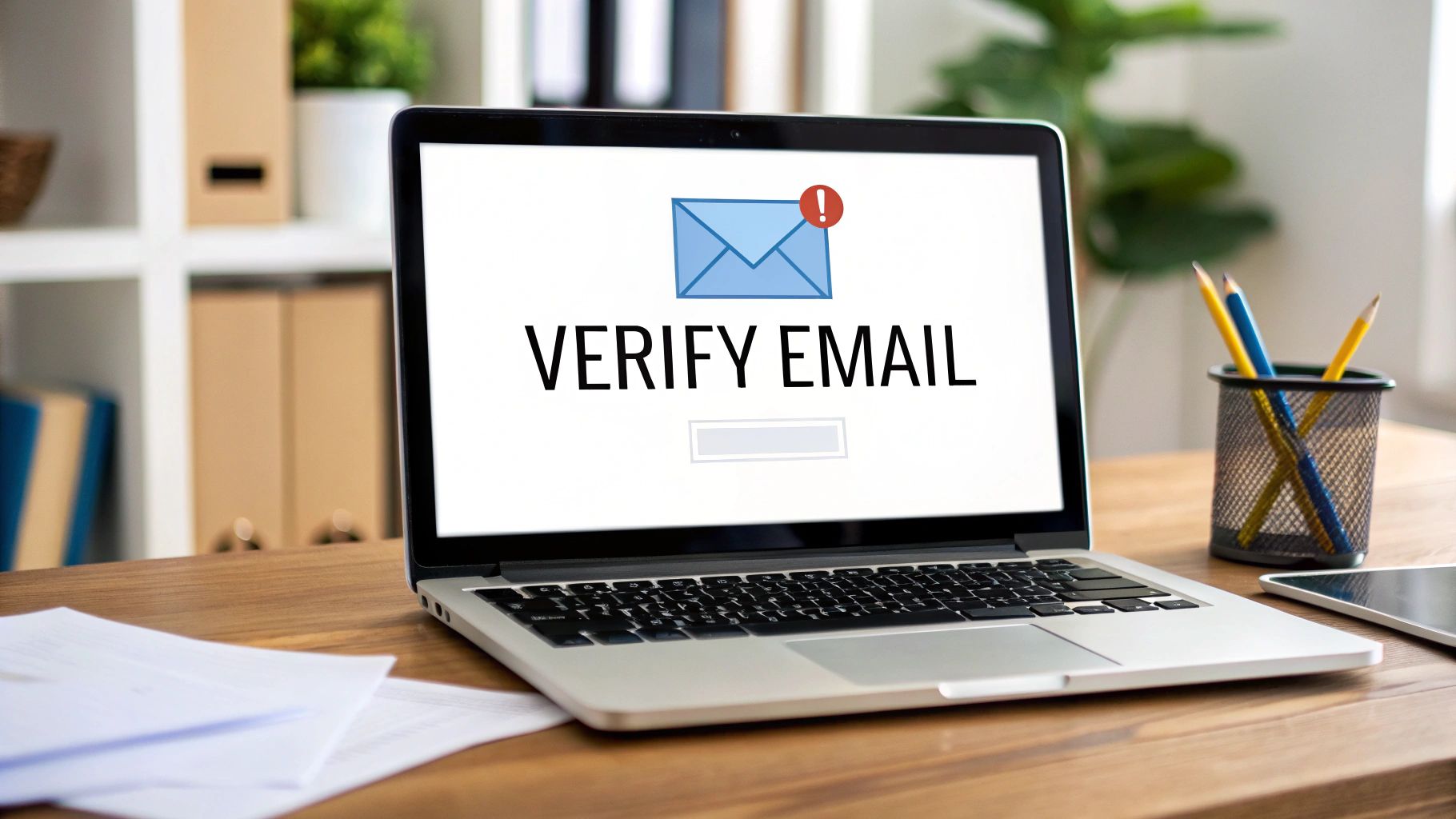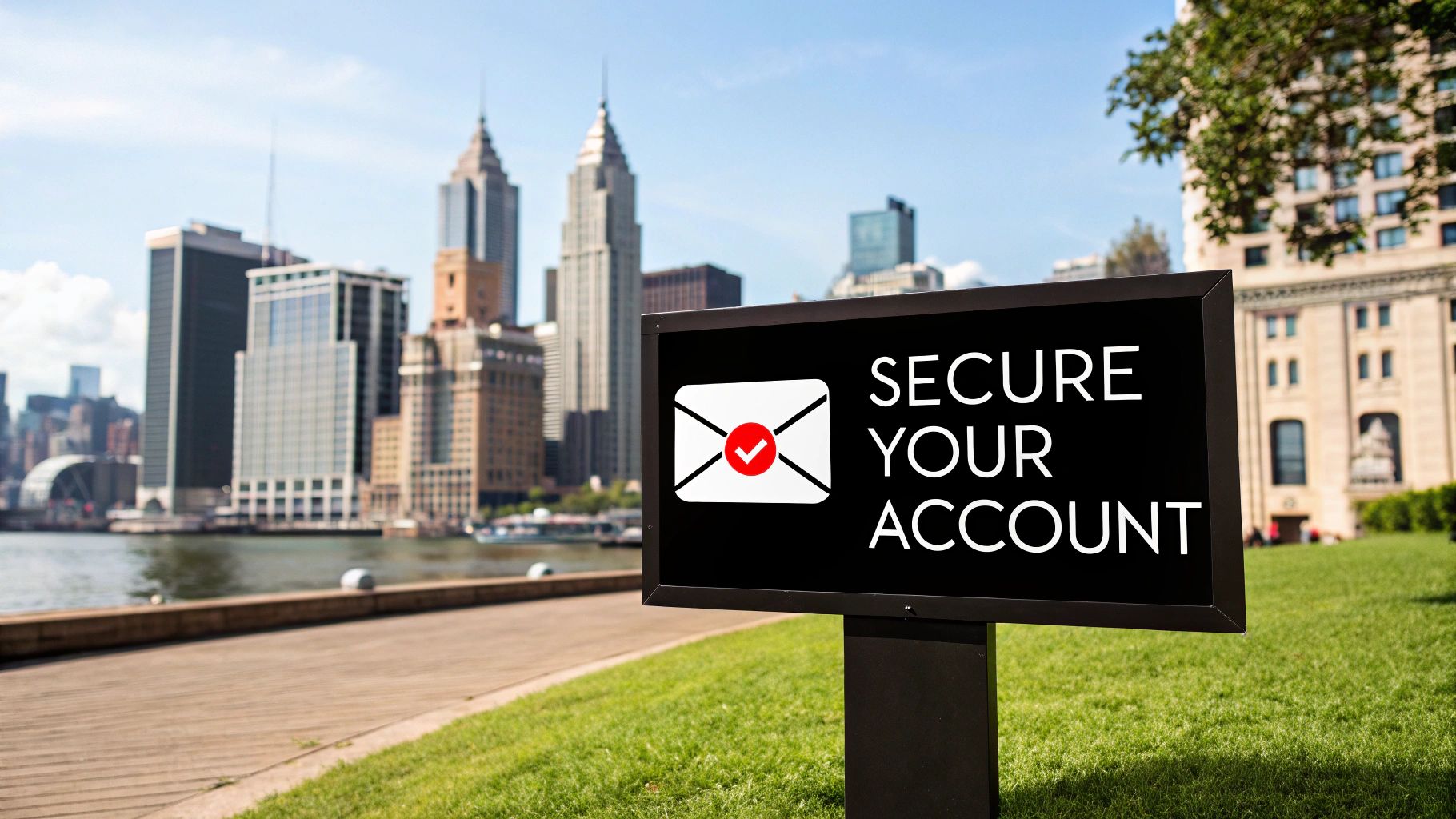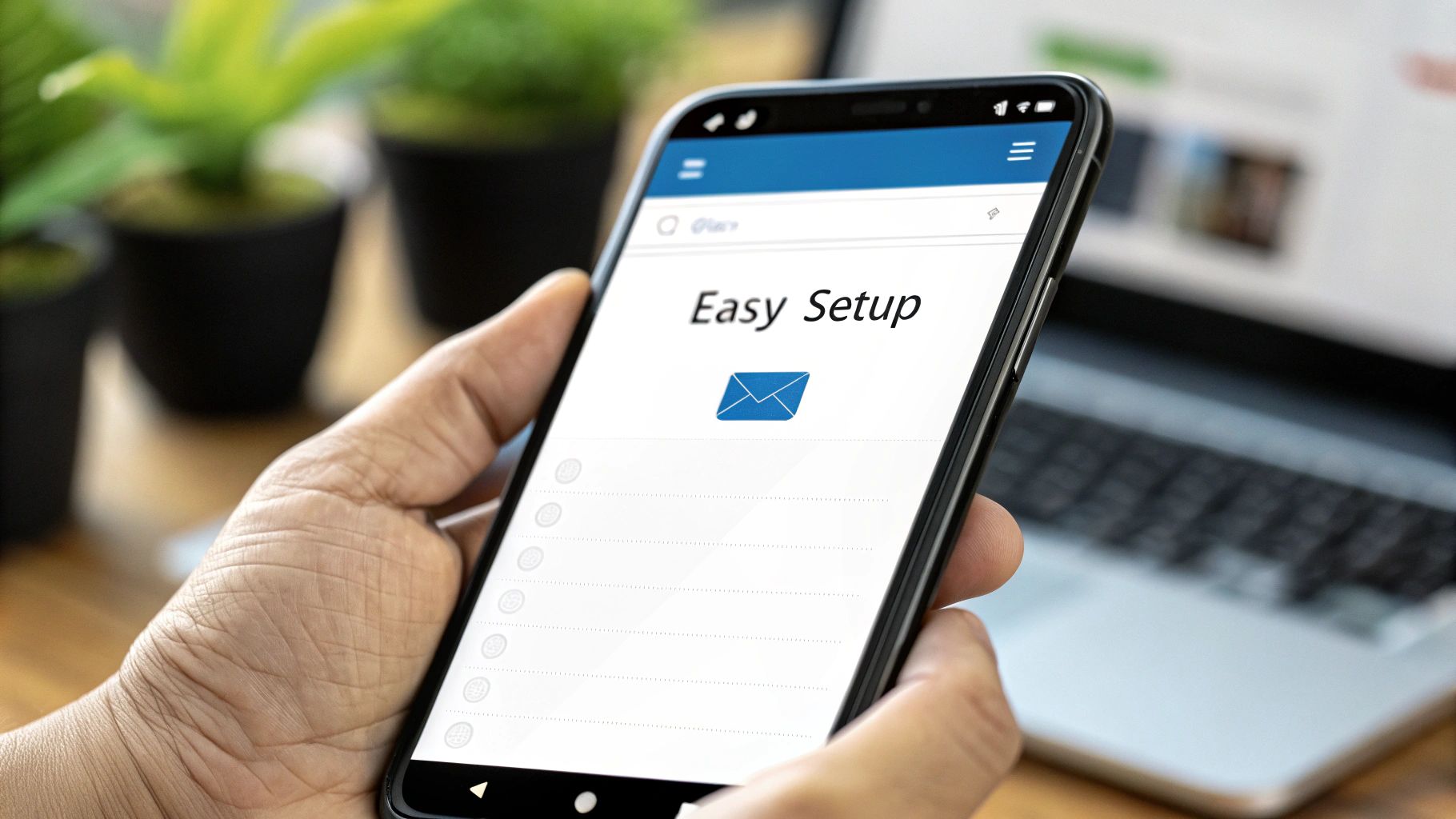Understanding the Email Verification Landscape
Email verification plays a key role in successful email marketing. It helps ensure your messages reach real users and maintains your sender reputation. Let's explore what email verification entails and why it matters for your campaigns.
Why Email Verification Matters
Quality email lists are built on valid, active addresses that engage with your content. Good verification reduces bounced emails and spam complaints while boosting engagement. An optimized email list means better results from your marketing investments.
The numbers show why verification is essential. Over 20% of registered email addresses contain errors like typos, formatting issues, and domain problems. These mistakes hurt deliverability – even a 1% increase in poor-quality emails can reduce delivery rates by 10%. Learn more in this analysis of Email Marketing Trends.
The Evolution of Email Verification
Smart companies now use advanced verification methods that go beyond basic checks. A complete verification process includes:
- Syntax Validation: Checking for proper email formatting
- Domain Verification: Confirming domain existence
- Mailbox Verification: Testing if the address can receive mail
- Catch-all Detection: Identifying domains that accept all emails
Regular list cleaning keeps your contacts current and accurate. For more details, check out this guide on How to master your email list hygiene.
Identifying Verification Challenges
Common verification issues to watch for include:
- Typos and Misspellings: Simple mistakes that cause delivery failures
- Inactive Addresses: Old or unused accounts that hurt sender scores
- Spam Traps: Fake addresses used to catch spammers
The Impact of Proper Verification
Real businesses see measurable benefits from verification. With cleaner lists, companies achieve higher inbox placement, open rates, and click-throughs. Even small improvements in bounce rates boost sender reputation significantly. Better deliverability means more opportunities for engagement and sales.
Using Modern Email Verification Technology
Keeping a clean email list requires more than basic error checking. Today's verification tools use advanced systems to make sure your messages reach the right people. Smart technology helps businesses manage their email lists more effectively.
How AI Makes Verification Better
Artificial intelligence now makes email verification much more thorough. Rather than just checking email formats, AI looks at patterns and behaviors to spot potential problems early. Think of it like having a detective reviewing your contacts.
For example, AI systems use data from past campaigns to check if an email address is real and active. This leads to better accuracy and automatic verification in real-time. The technology catches issues before they can hurt your sender reputation or cause high bounce rates. Learn more about where email verification is headed in this industry trends report.
Quick Checks and Smart Predictions
Modern verification tools include real-time validation that checks email addresses right when someone enters them. This stops bad data from getting into your system. The tools also use predictive analytics to spot potential delivery problems based on historical patterns.
You can find more details in our complete verification guide.
What Advanced Verification Does For You
Using better verification technology gives you several key benefits:
- Better Delivery: More emails make it to inboxes instead of spam folders
- Higher Engagement: Connect with people who actually want your messages
- Improved Results: Get more from your email campaigns
- Better Reputation: Build trust with email providers
- Smart Decisions: Use real data to improve your strategy
When you use advanced verification in your email marketing, you're investing in long-term success. Your messages will reach the right people, making your campaigns work harder for you.
Mastering Deliverability Through Strategic Verification
Email marketing success relies heavily on proper email verification. Having a solid strategy ensures your messages reach real inboxes while building a strong sender reputation. Let's explore the key aspects of email verification and how they help create lasting results.
The Power of Proactive Verification
Email verification isn't a one-and-done task. Email lists naturally degrade as people switch jobs, abandon old addresses, or make signup mistakes. Regular verification keeps your list fresh and helps your email verification messages consistently reach active subscribers.
Timing is Everything: When to Verify
Effective verification depends on your unique needs. Verify new signups immediately to prevent bad addresses from getting into your system. Set up regular monthly or quarterly checks to maintain list quality over time. Extra verification rounds are helpful after periods of rapid list growth or when you notice delivery problems.
Building a Verification System That Works
A good verification system uses multiple checks beyond basic formatting. Key features include domain verification, mailbox validation, and spam trap detection to ensure quality data. Connect your verification tool directly to your email platform to save time and effort. This lets you focus more energy on creating engaging email content.
The Impact on Deliverability Metrics
Email verification has a clear impact on results. With proper verification, less than 1% of supposedly valid emails will bounce. Even small bounce rates can damage sender reputation and future delivery. See full statistics here. By maintaining clean lists through regular email verification checks, businesses get better engagement and conversions. This leads to stronger results from your email marketing investment.
Crafting High-Converting Verification Emails
Email verification messages serve two key purposes – confirming subscriber details while also building engagement. By crafting these emails thoughtfully, you can turn a basic confirmation into an opportunity to connect with new subscribers. Let's explore how to create verification emails that drive action.
Writing Copy That Motivates Action
Understanding what motivates your audience is essential for effective verification emails. People are more likely to take action when they see clear value. Focus on communicating specific benefits they'll receive after verifying, such as members-only content, special deals, or an improved user experience.
Instead of a generic "Please verify your email," try something like "Get instant access to exclusive member benefits." This shows subscribers what's in it for them. You can also create urgency by mentioning any time-sensitive offers available after verification.
Design That Drives Results
Keep the design clean and focused on the verification action. Your emails should match your brand style while being easy to scan and click. The verification button should stand out visually and use clear action words like "Confirm Now" or "Activate My Account."
Include just enough visuals to support your message without cluttering the layout. The verification link or button should be immediately visible and accessible on any device.
Messaging For Your Audience
Match your tone and language to your specific audience. A younger crowd may prefer casual, fun copy while professionals typically want straightforward messaging. Test different subject lines and email content to see what gets the best response from your subscribers. You might be interested in: How to master email verification.
Proven Templates That Work
While customization is important, starting with a tested template can help ensure success. Strong verification emails typically include:
| Element | Description |
|---|---|
| Subject Line | Clear welcome message with verification prompt |
| Greeting | Brief, friendly welcome and thank you |
| Instructions | Simple steps to verify with clear benefit statement |
| CTA Button | Prominent, action-focused button |
| Value Props | Quick reminder of key membership benefits |
Following these guidelines helps transform basic verification emails into effective engagement tools that drive higher completion rates and set up strong subscriber relationships from the start.
Implementing Strategic Verification Workflows
Smart timing and automation make email verification work better. Let's explore proven ways that successful companies build verification into their processes to keep their email lists clean and effective long-term.
Balancing Immediate Needs and Long-Term Health
Think of email verification like tending a garden – you need to both remove bad addresses quickly and nurture good ones over time. Real-time verification when someone signs up stops invalid emails from getting in. Regular maintenance checks, like monthly list reviews, keep everything healthy as time goes on.
For example, many businesses verify new emails instantly during signup to block bad addresses. They also run monthly scans to find and remove inactive or outdated contacts, maintaining list quality over the long run.
Creating Smart Verification Workflows
The best verification happens at key moments in how people interact with you. When someone downloads content or registers for an event, you can send a quick verification email to confirm their address before giving access. This focused approach gets better results while avoiding annoying people.
Making Verification Work Automatically
Good automation saves time and helps verification run smoothly. Here are practical ways to do it:
- Smart Triggers: Send verification emails right after specific actions like new signups
- Win-Back Campaigns: Automatically try to re-verify inactive subscribers before removing them
- List Groups: Sort subscribers by engagement and verification status to send the right follow-up messages to each group
Real Examples of Automated Verification
Here's how an online store does it: When a new customer creates an account, they get an instant verification email. If they don't verify within 24 hours, a friendly reminder goes out automatically. This keeps their list clean with minimal work.
A media company takes a different approach with inactive subscribers. They identify people who haven't engaged recently and send a targeted verification campaign. This lets subscribers either confirm they want to stay on the list or be removed – improving email performance either way.
By using these methods, companies create verification systems that respond to how people actually behave. This helps get more emails verified while making list management much easier. Taking this proactive approach leads to better engagement and results from your email marketing.
Measuring and Scaling Verification Success
Once you've set up email verification, success comes down to tracking its impact effectively. This means looking at how verification influences your email marketing performance and analyzing data to find ways to improve.
Key Metrics for Verification Success
Measuring email verification requires looking at specific key performance indicators (KPIs). Here are the most important metrics to track:
- Verification Rate: What percentage of emails pass verification checks? Higher rates mean a cleaner signup process
- Bounce Rate: Track undelivered emails – verification should keep this under 1%
- Deliverability Rate: The percentage landing in inboxes vs spam folders
- Open Rate: While not directly tied to verification, higher open rates often mean better list quality
- Click-Through Rate (CTR): Like open rates, improved CTR suggests more engaged subscribers
- Spam Complaint Rate: Lower rates show better sender reputation
Building an Analytics Dashboard
Create a centralized dashboard combining data from your email platform and verification service. This gives you one place to monitor trends and see how verification impacts campaign results.
Identifying and Addressing Issues
Regular data analysis helps catch problems early. For example, if a signup form has low verification rates, it may need clearer instructions. If bounce rates suddenly increase, you might have invalid addresses entering your system. You might be interested in: How to master email verification.
Scaling Your Verification Strategy
As your list grows, verification must scale too. Focus on automation through:
- Real-time API verification on signup forms
- Automated list cleaning on a schedule
- Triggered verification emails based on subscriber behavior
This maintains list quality without manual work.
Data-Driven Decisions for Maximum ROI
Connect verification metrics to campaign performance to show the return on your investment. Use these insights to:
- Refine your verification approach
- Optimize email campaigns
- Predict and prevent deliverability issues
The result? Higher engagement, better sender reputation, and more effective email marketing.
Want precise email verification that gets results? EmailAddress.ai provides accurate verification to boost your email success. Visit us to learn more.





